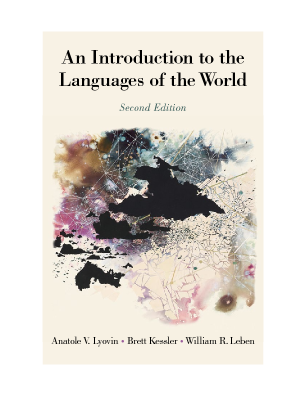An Introduction to the Languages of the World
Publication details
Lyovin, Anatole V. &
Kessler, Brett &
Leben, William R.
2017.
An introduction to the languages of the world.
2nd edn.
New York: Oxford University Press.
(ISBN 9780195149883 paperback; 9780190645274 ebook)
Official publication date is January, 2017, but copies are already available for purchase as paperback or ebook.
Services such as BookFinder4U can help you locate a vendor for the paperback edition.
Ebooks are available from sources such as Google Play, Barnes & Noble (Nook), and Amazon (Kindle).
See the Oxford University Press Web site for direct purchase of the paperback or more information.
Instructors can also use the OUP Web site to request an examination copy or instructor’s manual.
This is a second edition.
Please take note that the first edition (1997) is still being offered by many vendors.
If you are looking for the revised paperback, be sure to check the edition statement, the list of authors (the second edition adds Kessler and Leben), the ISBN, or the cover illustration: we now feature a new cartographic collage by Val Britton (click the picture to enlarge).
This second edition has 11 original maps as well as new sections on sign languages and language death and revitalization.
For greater readability, basic language facts are now organized in tables, and language samples follow international standards for phonetic transcription and word-by-word glossing.

By the numbers
- 466 pages of text (Table of Contents)
- 120 tables summarizing language and linguistic data (List of Tables).
The language tables display language names and their three-letter ISO 639-3 codes, language families and subgrouping, and the number of speakers and their main geographic concentration.
- 11 maps situating 800 languages.
Languages are identified by the same ISO codes used in the book’s tables and are accompanied by tags identifying families.
- over 1,500 entries each in the language and subject indexes, plus a table mapping from 1,029 ISO codes to language names.
- 231 pages of linguistic sketches giving more in-depth information, including a fully glossed sample text, for these 11 languages: Arabic, Chinese, Dyirbal, Finnish, Hawaiian, Quechua, Russian, Swahili, Tok Pisin, Tibetan, and Yup’ik.
Orthography is discussed and is included in the sample texts, but linguistic information is presented in phonemic transcription using the International Phonetic Alphabet.
Glossing follows the Leipzig Glossing Rules, with all symbols and abbreviations explained on first use in text and also expanded in alphabetical lists in the front of the book.
- 29 exercises distributed among the chapters, covering a range of languages and language topics.
Publisher’s summary
Unique in scope, An Introduction to the Languages of the World introduces linguistics students to the variety of world’s languages. It is ideal for use in courses where students have been exposed to the basic principles of linguistics but lack background in the broad range of language phenomena. They will gain familiarity with concepts such as sound change, lexical borrowing, diglossia, and language diffusion, and the rich variety of linguistic structure in word order, morphological types, grammatical relations, gender, inflection, and derivation. It offers students an opportunity to explore, at various levels, structures of varying and fascinating languages even with no prior acquaintance. While genetic ties among the languages are the focus, typological and sociolinguistic topics also play a role. A chapter is devoted to each of the world's continents, with in-depth analyses of representative languages of Europe, Asia, Africa, Oceania, and America, and separate chapters cover writing systems and pidgins and creoles. Each chapter contains exercises for the students and recommendations for further reading. There are eleven maps and extensive indexes of languages and subjects.
Anatole V. Lyovin is a retired Associate Professor of Linguistics at the University of Hawaiʻi at Mānoa.
Brett Kessler is Associate Professor Emeritus of Psychology in Arts & Sciences at Washington University in St. Louis.
William R. Leben is Professor Emeritus of Linguistics at Stanford University.